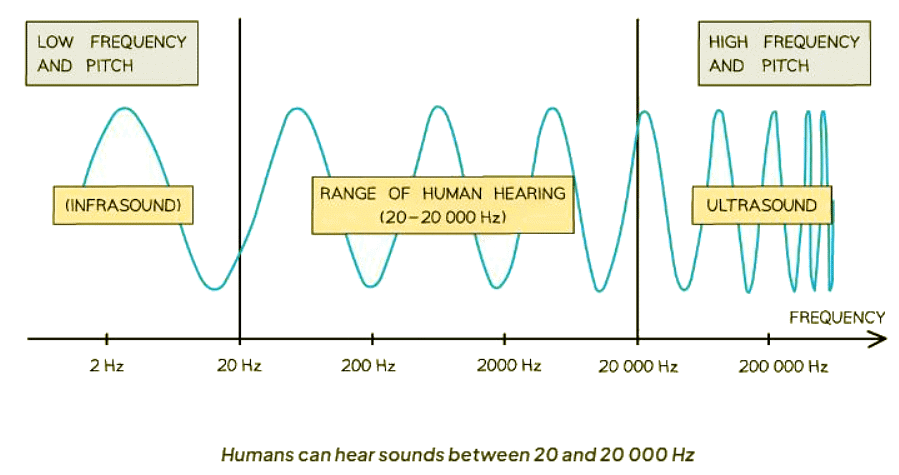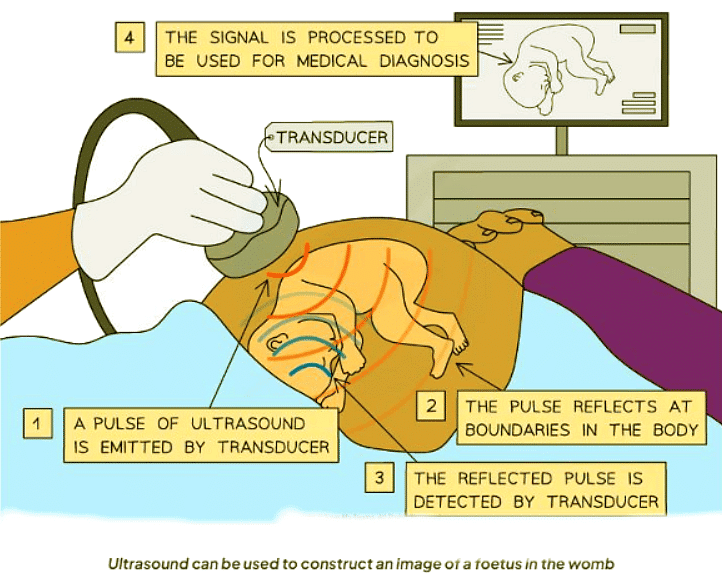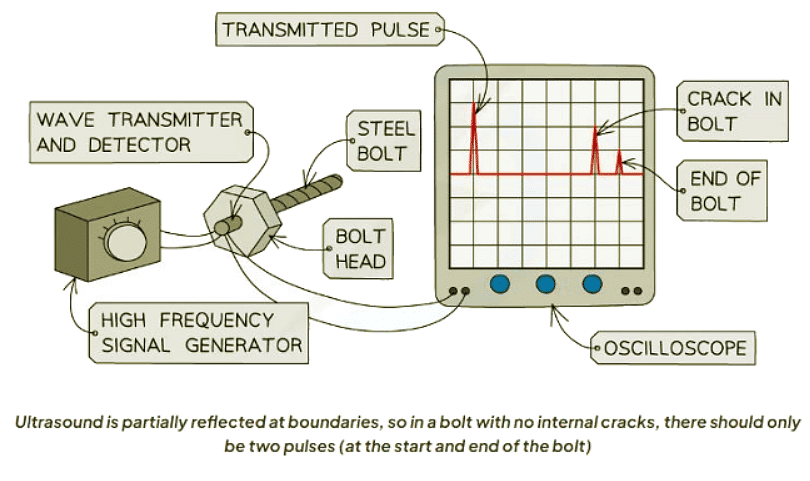Year 11 Exam > Year 11 Notes > Physics for GCSE/IGCSE > Ultrasound
Ultrasound | Physics for GCSE/IGCSE - Year 11 PDF Download
Ultrasound
- Humans have a hearing range between 20 Hz and 20,000 Hz, which may decrease with age.
- Ultrasound waves possess frequencies greater than 20,000 Hz.

- Humans perceive sounds within the 20 Hz to 20,000 Hz frequency range.
Uses of Ultrasound
- When ultrasound encounters a boundary between two different mediums, a portion of the waves is reflected back.
- The remaining waves pass through the material and are transmitted.
- Ultrasound transducers have the capability to both emit and receive ultrasound waves.
- Emit ultrasound waves
- Receive ultrasound waves
- The time taken for these reflected waves to reach a detector can be utilized to determine the distance to the boundary. This is achievable because ultrasound travels at varying speeds through different substances.
- The speed, distance, time equation can be applied to calculate this distance accurately.

- The speed, distance, time equation can be applied to calculate this distance accurately.
- Where:
- Speed (v): measured in meters per second (m/s)
- Distance (s): measured in meters (m)
- Time (t): measured in seconds (s)
- Ultrasound waves find applications in both medical and industrial imaging.
Ultrasound in Medicine
- Ultrasound in Medicine:
- Creates images of a developing fetus in the womb.
- Generates 2D images of organs and internal structures (excluding bone).
- Used in medical procedures like kidney stone removal.
- An ultrasound detector consists of a transducer responsible for emitting and receiving ultrasound waves into the body.
- The waves bounce back to the transducer upon encountering tissue boundaries in their path, such as between fluid and soft tissue or between tissue and bone.
- When these echoes reach the transducer, they create electrical signals transmitted to the ultrasound scanner.
- Utilizing the speed of sound and the time taken for each echo to return, the detector calculates the distance from the transducer to the tissue boundary.
- By conducting a series of ultrasound measurements across an area, these time measurements can be used to construct an image.
- The transducer within an ultrasound detector plays a crucial role in producing and receiving ultrasound waves within the body.
- Boundaries between different tissues, like fluid and soft tissue or tissue and bone, are key points where ultrasound waves reflect back to the transducer.
- Ultrasound, unlike many other medical imaging methods, is non-invasive and generally considered safe for imaging purposes.

Ultrasound in Industry
- Ultrasound serves various purposes in industries:
- Checking for cracks inside metal objects
- Generating images beneath surfaces
- When a metal block contains a crack, certain waves reflect earlier, appearing as distinct pulses on an oscilloscope trace. Each pulse corresponds to a boundary crossing.
- Each pulse signifies a wave boundary crossing.
- The constant speed of waves enables the calculation of distance from the source by measuring the time between emission and detection.

Question for UltrasoundTry yourself: What is the purpose of an ultrasound transducer in medical imaging?View Solution
The document Ultrasound | Physics for GCSE/IGCSE - Year 11 is a part of the Year 11 Course Physics for GCSE/IGCSE.
All you need of Year 11 at this link: Year 11
|
126 videos|148 docs|35 tests
|
FAQs on Ultrasound - Physics for GCSE/IGCSE - Year 11
| 1. What are the common uses of ultrasound imaging? |  |
Ans. Ultrasound imaging is commonly used for examining internal organs, monitoring pregnancy, diagnosing conditions like gallstones or kidney stones, and guiding procedures such as biopsies.
| 2. How does ultrasound work in medical imaging? |  |
Ans. Ultrasound uses high-frequency sound waves to create images of the inside of the body. These sound waves bounce off tissues and organs to create a real-time image that can be viewed on a screen.
| 3. Is ultrasound safe for pregnant women? |  |
Ans. Ultrasound is considered safe for pregnant women as it does not use radiation like X-rays. It is commonly used during pregnancy to monitor the fetus and check for any abnormalities.
| 4. Can ultrasound be used to detect cancer? |  |
Ans. Yes, ultrasound can be used to detect cancer by imaging the affected area and identifying any abnormal growths or tumors. It is often used in conjunction with other imaging tests for a more accurate diagnosis.
| 5. What are the limitations of ultrasound imaging? |  |
Ans. Ultrasound imaging may not provide as detailed images as other imaging techniques like MRI or CT scans. It is also limited by the depth it can penetrate, making it less effective for imaging structures deep within the body.
Related Searches













